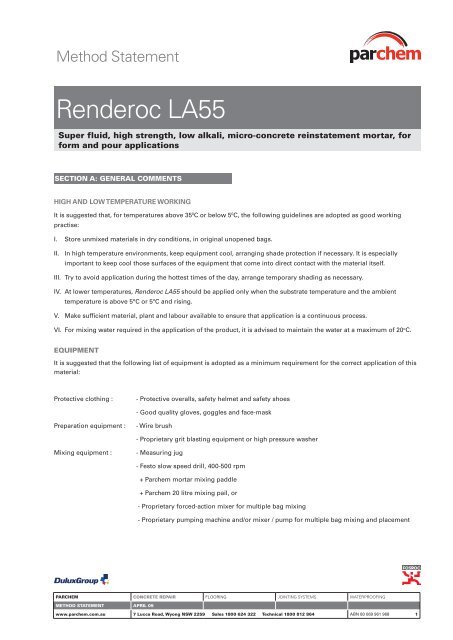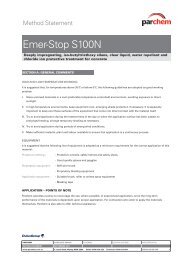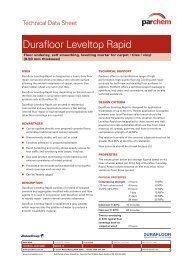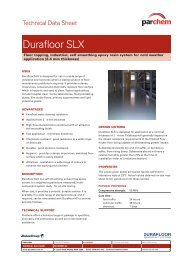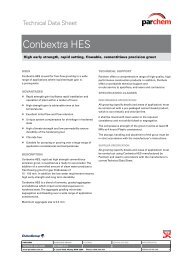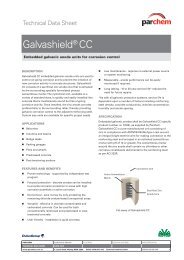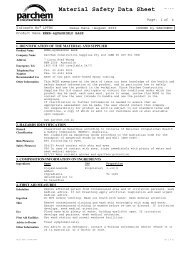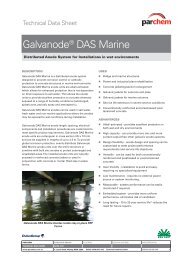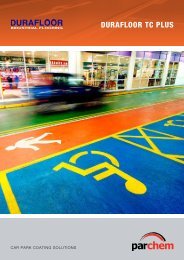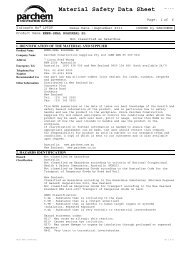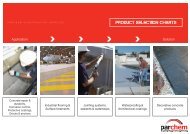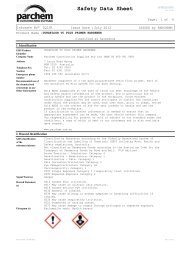Renderoc LA55 Method Statement - Parchem
Renderoc LA55 Method Statement - Parchem
Renderoc LA55 Method Statement - Parchem
You also want an ePaper? Increase the reach of your titles
YUMPU automatically turns print PDFs into web optimized ePapers that Google loves.
<strong>Method</strong> <strong>Statement</strong><strong>Renderoc</strong> <strong>LA55</strong>Super fluid, high strength, low alkali, micro-concrete reinstatement mortar, forform and pour applicationsSECTION A: GENERAL COMMENTSHIGH AND LOW TEMPERATURE WORKINGIt is suggested that, for temperatures above 35 0 C or below 5 0 C, the following guidelines are adopted as good workingpractise:I. Store unmixed materials in dry conditions, in original unopened bags.II. In high temperature environments, keep equipment cool, arranging shade protection if necessary. It is especiallyimportant to keep cool those surfaces of the equipment that come into direct contact with the material itself.III. Try to avoid application during the hottest times of the day, arrange temporary shading as necessary.IV. At lower temperatures, <strong>Renderoc</strong> <strong>LA55</strong> should be applied only when the substrate temperature and the ambienttemperature is above 5°C or 5ºC and rising.V. Make sufficient material, plant and labour available to ensure that application is a continuous process.VI. For mixing water required in the application of the product, it is advised to maintain the water at a maximum of 20 o C.EQUIPMENTIt is suggested that the following list of equipment is adopted as a minimum requirement for the correct application of thismaterial:Protective clothing :- Protective overalls, safety helmet and safety shoes- Good quality gloves, goggles and face-maskPreparation equipment :- Wire brush- Proprietary grit blasting equipment or high pressure washerMixing equipment :- Measuring jug- Festo slow speed drill, 400-500 rpm+ <strong>Parchem</strong> mortar mixing paddle+ <strong>Parchem</strong> 20 litre mixing pail, or- Proprietary forced-action mixer for multiple bag mixing- Proprietary pumping machine and/or mixer / pump for multiple bag mixing and placementPARCHEM CONCRETE REPAIR FLOORING JOINTING SYSTEMS WATERPROOFINGMETHOD STATEMENT APRIL 09www.parchem.com.au 7 Lucca Road, Wyong NSW 2259 Sales 1800 624 322 Technical 1800 812 864 ABN 80 069 961 968 1
<strong>Renderoc</strong> <strong>LA55</strong>APPLICATION – POINTS OF NOTE<strong>Parchem</strong> operates a policy to encourage the use, where possible, of experienced applicators, since the long-termperformance of the materials is dependant upon proper application. For contractors who wish to apply the materialsthemselves, <strong>Parchem</strong> is also able to offer technical assistance.SECTION B: APPLICATION METHOD1.0 REPAIR AREAS1.1 The areas to be repaired are to be as shown on the drawings or as indicated by the Contract Administrator. The areasare to be clearly marked out on site and agreed with the Contract Administrator before proceeding.1.2 The areas may be adjusted by the Contract Administrator as work proceeds according to the conditions found.1.3.1 Propping shall be provided as noted on the drawings or as agreed by the Contract Administrator.1.4 The surfaces adjacent to and of areas for repair shall be cleaned to remove any dust, unsound material, plaster, oil,paint, grease, corrosion deposits, organic growth, etc.1.5 Within the repair area, the concrete cover to reinforcement links or main bars shall be determined by cover meter. Asmall area shall be chiselled out and the concrete cover and the depth of deteriorated concrete confirmed bymeasurement.2.0 CONCRETE PREPARATION2.1 The equipment and methods used to break out the concrete shall be such that no reinforcing steel or other embeddeditems such as conduits or lifting sockets, etc., are loosened, damaged or removed, unless so directed by the ContractAdministrator.2.2 If reinforcement is found to be congested, making difficult the removal of concrete by mechanical means, then highpressure water jetting shall be considered and a necessary provision for protecting the rest of the structure shall beallowed for.2.3 The prepared void shall be profiled so that entrapment of air during the process of placing the fluid micro-concrete isavoided.2.4 Using a saw, disc cutter, or other suitable tool, the perimeter of the area to receive fluid micro-concrete shall be incisedto a depth of at least 10 mm causing good arrises to be formed at outer edges all to preclude feather edging. Theminimum section thickness of installed <strong>Renderoc</strong> <strong>LA55</strong> fluid micro-concrete shall be 50 mm.2.5 All concrete surfaces against which fluid micro-concrete is to placed shall be of a rough scabbled nature. Saw/disc cutedges shall be grit blasted to lightly roughen.2.6 All physically damaged, poorly compacted, loose, cracked or friable concrete shall be removed until sound concrete isreached. This preparation shall be such as to leave a sound exposed concrete substrate free from dust, loose particlesand any deleterious matter.2.7 Due account shall be taken of any propping or other instructions given by the Contract Administrator regardingsequences of removal and repair.Additional considerations where concrete is affected by carbonation2.8 The agreed area shall be broken out to remove all contaminated concrete. Where the depth corresponds to the depth ofconcrete cover and thereby exposes reinforcement, breaking out shall continue to expose the full circumference of thesteel and to a further depth of 25 mm or as directed by the Contract Administrator. Breaking out shall continue along thereinforcement until non-corroded steel is reached and shall continue 50 mm beyond this point or as directed by the2
<strong>Renderoc</strong> <strong>LA55</strong>Contract Administrator. Special care shall be exercised to ensure that any reinforcement exposed is not cut or damaged.2.9 After breaking out as specified the exposed surface of concrete shall be tested for carbonation by the use of a semiaqueoussolution of phenolphthalein. The test shall be carried out on the freshly exposed concrete or at least within 30minutes of being exposed. The test shall be carried out on sound, dry and clean air-blown dust free surfaces. If theconcrete substrate still exhibits carbonation in the vicinity of the steel reinforcement, breaking out to remove a further20 mm shall be carried out and the test repeated. If carbonation is still present the Contract Administrator shall benotified before proceeding further.2.10 It is essential that no carbonated concrete substrate shall be in contact with, or within 5 mm of, the reinforcing bars. Incases where carbonation has reached within 5 mm of the reinforcing bars, the concrete shall be broken out to exposethe full circumference of the steel and a further depth of 20-30 mm or as directed by the Contract Administrator.Additional considerations where concrete is affected by chlorides2.11 Where it is determined that chlorides are present in the concrete the agreed area(s) shall be broken out to remove allcontaminated concrete, or, having regard to the steel reinforcement, to a depth as directed by the ContractAdministrator.NOTE: Chloride values are generally expressed in percentage terms of weight of chlorides by weight of concrete: 0.05%- 0.15% medium risk; above 0.15% high risk, though where chloride penetration from external sources is involved, therisk of corrosion in the medium risk range is much greater, and corrosion has been found to occur at levels below0.05%.Reinforcing steel / concrete not affected by carbonation or chlorides2.12 Where exposed reinforcement is sound and there are no signs of corrosion other than typical of its original condition itshall be mechanically cleaned of rust and loose millscale. Where there are signs of corrosion deterioration it shall becleaned of corrosion products by wet grit blasting or other approved means to achieve a surface finish to comply with astandard of steel cleanliness such as SA21/2 (BS7079:Part A1 / ISO8501) or as directed by the Contract Administrator.3.0 REINFORCING STEEL3.1 All exposed reinforcement shall be cleaned of corrosion products by wet grit blasting or other approved means toachieve a surface finish to comply with a standard of steel cleanliness such as SA21/2 (BS7079:Part A1 / ISO8501) or asdirected by the Contract Administrator. Special care shall be taken to clean out properly any pitting that may haveoccurred in the steel bar.3.2 When the corrosion products have been removed and if directed by the Contract Administrator, the diameter of thereinforcing bar(s) shall be measured. If considered necessary by the Contract Administrator the existing reinforcementshall be cut out and replaced and/or additional bars added in accordance with instructions. Any deep pitting of thereinforcing bars shall be brought to the attention of the Contract Administrator.3.3 Reinforcement damaged during the removal of concrete or the preparation process shall be brought to the attention ofthe Contract Administrator and if required, shall be repaired or replaced.4.0 REINFORCEMENT PRIMING4.1 Immediately following preparation and cleaning, the reinforcing steel shall be primed with Nitoprime Zincrich, a singlecomponent epoxy primer complying with the relevant parts of BS4652, 1971 (1979) Specification For Metallic ZincRich Priming Paint Type 2.4.2 The Nitoprime Zincrich shall be brush applied to the cleaned reinforcement ensuring that all exposed steel is fullycoated. Special attention shall be paid to the backs of the steel bars and where steel bars are tied together. It is essentialthat this coat is continuous with that of any adjacent repaired area where zinc-rich primer has been used. Avoidexcessive overpainting onto the concrete and allow to dry.3
<strong>Renderoc</strong> <strong>LA55</strong>5.0 FORMWORK5.1 Adequate formwork shall be provided in accordance with the relevant codes of practice. It shall be constructed fromappropriate materials as agreed with the Contract Administrator and shall be watertight at all joints between panels,and between formwork and the existing concrete.5.2 The formwork shall be securely fixed to withstand the hydraulic pressures of the fluid micro-concrete without distortionor movement during and subsequent to placement. It may be necessary to divide into suitably sized sections.5.3 Formwork surfaces that are to be in contact with the fluid micro-concrete shall be foil-faced, or shall receive two coatsof polyurethane shutter paint and be treated with a suitable release agent such as Reebol in accordance with currentinstructions for use.5.4 The formwork shall include bottom drainage outlets for pre-soaking water, provision for introduction of the microconcreteand air venting as required. The introduction and venting points shall be located so as to avoid any possibilityof entrapment of air, etc. Where necessary provision shall be made for controllable venting points to prevent airentrapment and enable the extent of flow of the fluid micro-concrete to be assessed.6.0 PRE-SOAKING6.1 The formwork shall be inspected by the Contract Administrator and if approved, the void filled with clean water andkept full. This shall remain for a minimum of 2 hours, then the formwork shall be completely drained and resealedimmediately prior to introducing the fluid micro-concrete.7.0 MIXING MICRO-CONCRETE7.1 Only mixes using complete bags of <strong>Renderoc</strong> <strong>LA55</strong> shall be allowed and part bag mixes shall not be permitted.7.2 The mixing shall be carried out strictly in accordance with current product instructions for use and only appropriatemixing equipment will satisfy.7.3 The mixing water shall be potable quality and the carefully measured quantity of water 2.4 – 2.8 litres shall be placedinto the mixing container before the <strong>Renderoc</strong> <strong>LA55</strong>.7.4 The <strong>Renderoc</strong> <strong>LA55</strong> shall be added to the mixing water and in no circumstances shall more water be added than themaximum volume specified for each bag.8.0 CONCRETING8.1 When assessed in accordance with the flow measurement requirements of DTp BD27/86 the <strong>Renderoc</strong> <strong>LA55</strong> shall flow850 mm along the test trough within 15 seconds, without segregation or bleeding.8.2 Test cubes may be made at intervals if required by the Contract Administrator. They shall be made in 100 mm metalmoulds to BS1881:Part 108. The moulds shall be carefully filled to avoid air entrapment. There shall be no compactionand the top of each cube shall be covered by a metal plate with a weight not less than 0.5 kg. The cubes shall then becured and tested in accordance with the relevant parts of AS1012.13.8.3 Poured material shall be introduced slowly into the formwork. It may be introduced via a funnel, or hopper, at the topof the formwork, unless the configuration of the repair necessitates the use of external pipe-work to reach remote partsof the void. The entry point(s) shall be designed to provide sufficient head of material to ensure total displacement of air.8.4 Vent/witness points shall be provided so that when all air has been displaced, the arrival of good quality grout may beobserved. If this is preceded by the arrival of any water or grout-bleed, pouring shall continue until good grout is seento issue.8.5 The placing of the <strong>Renderoc</strong> <strong>LA55</strong> shall be, as far as possible, continuous.8.6.1 Mixing shall be timed so that there is minimal interruption to material placing. If, however, placing is interrupted, thisshall be brought immediately to the attention of the Contract Administrator. The operation may continue while the<strong>Renderoc</strong> <strong>LA55</strong> retains its flow characteristics.8.7 Where fluid <strong>Renderoc</strong> <strong>LA55</strong> is poured in sections, the previously cast edge at the stop end face shall be suitablyroughened and cleaned.4
<strong>Renderoc</strong> <strong>LA55</strong>8.8 <strong>Renderoc</strong> <strong>LA55</strong> shall not be placed when the ambient or substrate temperature is below 5°C or above 35°C nor atambient temperatures of 5°C on a falling thermometer. In cold conditions down to 5°C the use of warm water, up to30°C shall be permitted for pre-soaking and mixing.9.0 FORMWORK REMOVAL9.1 The formwork shall not be removed for 1 day, where the repair area is subject to tidal conditions. Where the repair areais out of the tidal zone the formwork shall be removed once <strong>Renderoc</strong> <strong>LA55</strong> has achieved a compressive strength of atleast 10 MPa or as directed by the Contract Administrator.10.0 CURING10.1 Details of the methods of curing shall be submitted to the Contract Administrator for approval.10.2 Curing shall be instigated immediately after removal of the formwork.10.3 Concure WB30 may be low pressure spray applied as a curing membrane. In fast drying conditions it will benecessary to supplement this with polyethylene sheet taped around its edges. Where a Dekguard protective coating isto be applied over the repair area then Nitobond AR should be used to as the curing membrane.SECTION C: IMPORTANT NOTEThis method statement is offered by <strong>Parchem</strong> as a ‘standard proposal’ for the application of <strong>Renderoc</strong> <strong>LA55</strong>. It remains theresponsibility of the Customer to determine the correct method for any given application.<strong>Parchem</strong> does not accept any liability either directly or indirectly for any losses suffered in connection with the use orapplication of the product whether or not in accordance with any advice, specification, recommendation or informationgiven by it.PARCHEM CONCRETE REPAIR FLOORING JOINTING SYSTEMS WATERPROOFINGMETHOD STATEMENT APRIL 09www.parchem.com.au 7 Lucca Road, Wyong NSW 2259 Sales 1800 624 322 Technical 1800 812 864 ABN 80 069 961 9685


